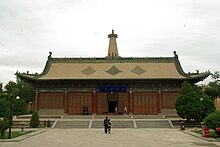Zhangye
|
Zhangye 张掖市 |
|
|---|---|
| Prefecture-level city | |

Near Aviko french fry factory in Liuba Town, Minle County, Zhangye
|
|
 Location of Zhangye City jurisdiction in Gansu |
|
| Coordinates: 38°36′N 100°27′E / 38.600°N 100.450°E | |
| Country | China |
| Province | Gansu |
| Area | |
| • Total | 42,000 km2 (16,000 sq mi) |
| Population (2010) | |
| • Total | 1,199,515 |
| Time zone | China Standard (UTC+8) |
| Postal code | 734000 |
| Website | zhangye |
| Zhangye | |||||||||

The Dafo Temple, site of the largest reclining Buddha in China.
|
|||||||||
| Traditional Chinese | |||||||||
|---|---|---|---|---|---|---|---|---|---|
| Simplified Chinese | |||||||||
| Postal | Changyeh | ||||||||
|
|||||||||
| Transcriptions | |
|---|---|
| Standard Mandarin | |
| Hanyu Pinyin | Zhāngyè |
| Wade–Giles | Chang1-yeh4 |
| Former names | |||||||||
| Ganzhou | |||||||||
|---|---|---|---|---|---|---|---|---|---|
| Chinese | |||||||||
| Literal meaning | Sweet [Spring(s)] Prefecture | ||||||||
|
|||||||||
| Transcriptions | |
|---|---|
| Standard Mandarin | |
| Hanyu Pinyin | Gānzhōu |
| Wade–Giles | Kan-chou |
Zhangye, formerly romanized as Changyeh or known as Kanchow, is a prefecture-level city in central Gansu Province in the People's Republic of China. It borders Inner Mongolia on the north and Qinghai on the south. Its central district is Ganzhou, formerly a city of the Western Xia and one of the most important outposts of western China.
The city was formerly known as Ganzhou, named after the sweet waters of its oasis. The name is retained by both Zhangye's central district and province. The name appears in Marco Polo's Travels under the name Campichu.
Zhangye was used as the name of the area's commandery and then for the city itself. The name Zhangye ("Extending Arm") is excerpted from the phrase "To extend the arm of the country through to the Western Realm" (张国臂掖,以通西域).
Zhangye lies in the center of the Hexi Corridor. The area is on the frontier of China Proper, protecting it from the nomads of the northwest and permitting its armies access to the Tarim Basin. During the Han Dynasty, Chinese armies were often engaged against the Xiongnu in this area. It was also an important outpost on the Silk Road. Before being overrun by the Mongols, it was dominated by the Uyghurs from at least the early 10th century. Its relation to the larger Uyghur state of Qocho is obscure, but it may have been a vassal.
...
Wikipedia
